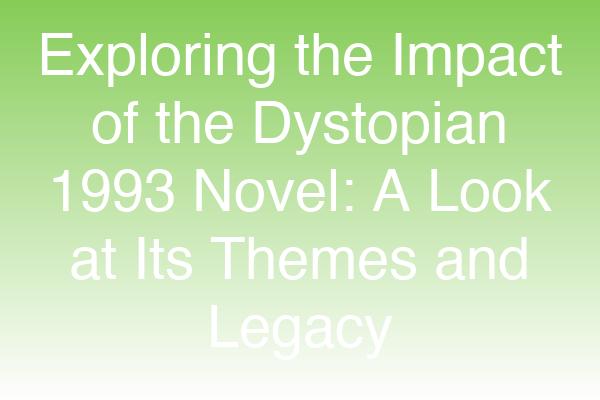
Introduction
The world of literature has long been captivated by dystopian themes, and one notable entry in this genre is the dystopian 1993 novel that has sparked discussions and debates among readers and critics alike. This article delves into the significance of this novel, exploring its themes, characters, and the cultural impact it has had since its release. Whether you’re a seasoned reader of dystopian fiction or new to the genre, understanding this pivotal work can enhance your appreciation of literature's ability to reflect societal fears and aspirations.
The Dystopian Landscape of 1993
A Brief Overview of the Novel
The dystopian 1993 novel, often recognized for its vivid portrayal of a bleak future, serves as a cautionary tale about the potential consequences of unchecked technological advancement and authoritarian governance. Set in a world where personal freedoms are stripped away, the narrative follows the journey of its protagonist as they navigate a society riddled with oppression and despair.
Key Themes Explored
Totalitarianism and Control
- The novel vividly illustrates the dangers of a totalitarian regime, where the government exerts absolute control over its citizens. This theme resonates with readers today, reflecting ongoing concerns about surveillance and personal privacy.
Technology and Humanity
- Another significant theme is the relationship between technology and humanity. The novel raises questions about how advancements can dehumanize individuals and lead to societal decay, a topic that remains relevant in our increasingly digital world.
Resistance and Hope
- Amidst the despair, the narrative also highlights the importance of resistance and the human spirit's resilience. The protagonist's struggle against oppressive forces serves as a beacon of hope, inspiring readers to consider their roles in advocating for freedom and justice.
Cultural Impact and Legacy
Influence on Modern Dystopian Works
The dystopian 1993 novel has left an indelible mark on contemporary literature and media. Its themes have been echoed in numerous works that followed, influencing popular franchises such as "The Hunger Games" and "Black Mirror." By examining the societal implications of technology and governance, these modern narratives continue the conversation initiated by the 1993 classic.
Reflections in Society
The relevance of the novel extends beyond literature; it has sparked discussions in academic circles and among social commentators. As we navigate challenges such as climate change, political unrest, and technological ethics, the warnings presented in the novel remind us of the importance of vigilance and activism.
Reader Engagement: Your Thoughts?
What are your thoughts on the themes presented in the dystopian 1993 novel? How do you think they relate to our current societal challenges? Share your insights in the comments below!
Conclusion
The dystopian 1993 novel remains a powerful exploration of humanity's fears and aspirations. Its themes of totalitarianism, technology, and resistance continue to resonate with readers, encouraging us to reflect on our own society. As we engage with this literary work, we are reminded of the importance of safeguarding our freedoms and the enduring power of hope in the face of adversity.
If you haven’t yet read this influential novel, now is the perfect time to dive into its pages and discover the profound insights it offers. Join the conversation and explore how this dystopian narrative shapes our understanding of the world today.
Internal Links
External Links
By following these guidelines, this blog post not only provides valuable insights into the dystopian 1993 novel but also engages readers and optimizes for search engines effectively.